Earlier in the week dawn broke with thick fog obscuring the school buildings next door and the tall lime trees framing the building’s main lawn. Temporarily cut off, as is the way of things, the tree tops gradually re-appeared, followed by the familiar views of neighbouring buildings as well as the sound of passing traffic. Not much at the moment as this part of South West London, like so many other places, has in large part shut down. Our nearby Italian restaurant, the place we have gone to in all sorts of moods and moments, is closed now and won’t re-open until the New Year. The staff hope to reach Italy to be with their families, and we wonder if we will ever experience their warm welcome again.
Yesterday, December 21st was the longest night of the year, the Winter solstice, for those of us living in the Northern hemisphere. A predictable turning point. The days will now slowly lengthen, imperceptably at first, but nevertheless I’m aware that the certainty of the year turning, and Spring a measurable distance away, has been particularly significant this year as last, as so many familiar certainties have been overturned in one way or another.
Meanwhile, today we have bright wintry sunshine and I’ve added watering to my pre-Christmas ‘to do’ list, not so much by way of rescuing the windswept containers out in the open, but as a life-saver for the plants, including well established roses and cistus, in the containers in the rain-shadow, close to the building and under the overhang of the industrial roof. The original was lost to fire when hit by an incendiary bomb in the last war, taking with it the whole top floor, once a formidable construction with Gothic ambitions, including extraordinarily steeply pitched roofs and elaborate gables. The much later conversion of the Edwardian red-brick, disused shell, from educational to domestic use, included the addition of a new roof with plain, rather featureless replacement flats immediately underneath. What they may lack in ornate architecture they have gained by having far-reaching views and space for gardening with all the rewards of a personal outdoor space for socialising and more particularly the sensory pleasures of a plant filled space.
Aiming High
One advantage of living at altitude (on the fifth floor to be exact although this includes the internal staircases within the ground floor duplex flats which go unrecognised by the lift and the communal landings) with the main balcony partially covered by the overhanging roof and leading off the main bedroom, is that at this height and with no other tall buildings nearby, drawing the curtains or pulling down blinds is an optional extra. So on waking I generally see a carefully selected group of plants immediately in front of the sliding doors with majestic tree tops and the nearby church spire beyond. In truth there are the multipurpose playgrounds of the modern secondary school in-between but these are well below my eyeline first thing in the morning.
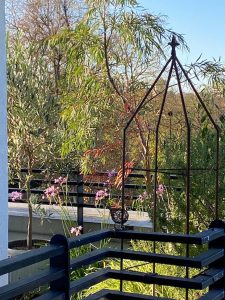 Some are established containers with loyal contents such as salvias and hellebores which I move round with the seasons. Other pots are picked for their transient interest (bulbs at this time of year ready for Spring) as well as larger plants that prefer to huddle close to the warmth and shelter of the building to avoid the worst of the westerly winds and driving rain, which in the Winter months can easily upset the gentle equilibrium aloft. Unexpectedly however, some pelegoniums (more familiarly known as geraniums, and not to be confused with hardy geraniums) which are still right out in the open, with night-time temperatures dropping to 4 degrees or below (I live with someone who likes precise data and has an indoor/outdoor temperature gauge) have just struggled into flower again, retaining their customary vivid pink but without the profusion of high Summer.
Some are established containers with loyal contents such as salvias and hellebores which I move round with the seasons. Other pots are picked for their transient interest (bulbs at this time of year ready for Spring) as well as larger plants that prefer to huddle close to the warmth and shelter of the building to avoid the worst of the westerly winds and driving rain, which in the Winter months can easily upset the gentle equilibrium aloft. Unexpectedly however, some pelegoniums (more familiarly known as geraniums, and not to be confused with hardy geraniums) which are still right out in the open, with night-time temperatures dropping to 4 degrees or below (I live with someone who likes precise data and has an indoor/outdoor temperature gauge) have just struggled into flower again, retaining their customary vivid pink but without the profusion of high Summer.
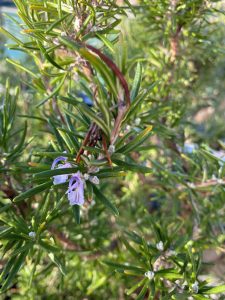 A number of relatively large plants and shrubs including olives, eucalyptus, bay and rosemary, as well as the deciduous euonymous europaeus ‘Red Cascade’, are in semi-permanent positions around the perimeter of the roof garden. However, I hadn’t realised until it was pointed out to me by an observant visitor, to what extent it is their height that somehow ‘makes the space’. I know what she meant, although of course not everyone will agree, and I have bought another plant with the boundary in mind. This time an evergreen escallonia ‘Peach Blossum’, which I am pleased to read is rabbit resistant, and which I acquired when visiting the award winning Burncoose nursery not far from the coast in Cornwall. The growing conditions in the gardens of the South West of England have little in common with balconies in the South West of London, but armed with a bag of ericaceous compost to accomodate its Ph preferences, and planted in a protected corner, I am hoping it will do well.
A number of relatively large plants and shrubs including olives, eucalyptus, bay and rosemary, as well as the deciduous euonymous europaeus ‘Red Cascade’, are in semi-permanent positions around the perimeter of the roof garden. However, I hadn’t realised until it was pointed out to me by an observant visitor, to what extent it is their height that somehow ‘makes the space’. I know what she meant, although of course not everyone will agree, and I have bought another plant with the boundary in mind. This time an evergreen escallonia ‘Peach Blossum’, which I am pleased to read is rabbit resistant, and which I acquired when visiting the award winning Burncoose nursery not far from the coast in Cornwall. The growing conditions in the gardens of the South West of England have little in common with balconies in the South West of London, but armed with a bag of ericaceous compost to accomodate its Ph preferences, and planted in a protected corner, I am hoping it will do well.
I have been lucky with other plants that shouldn’t like the local conditions and I do recommend experimentation. I also suggest that when buying or creating obelisks or other structures for climbing plants, go big or certainly go tall, as tall structures are more impressive, certainly up aloft; against wide skies they look good even when un-clad and maybe cheaper in the long run. And as someone who enjoys looking up at other roof gardens and balconies as I wander through our local urban landscape, hoping for treetops and other signs of plant life and horticultural interest, which in turn will contribute to albeit a rather fragmented green corridor amidst the turmoil and intensity of city life.
Which of course touches on some of the significant differences between gardening on a small area of roofing material, in a more traditional urban garden space or in a expansive country garden. Everything is imported; pots, plants, compost, plant supports and plant food. Watering is by hand for the most part and there is a high price to pay for neglect as feeding too (seaweed based in my case) is essential for survival or certainly to flourish. The greener options of home-maid comfrey, which has an appalling smell, or nettle feed, are inpractical and would overstretch the tolerance of my very patient partner in life, and the end product of the communal compost bins is understandably destined for the gardens below.
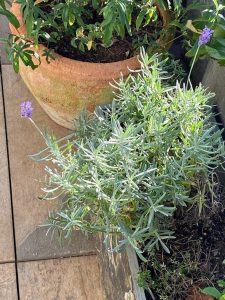 The pollinators come and linger on late into the Autumn; other beneficial insects too, with ladybirds in particular being well established visitors. The plants keep the building noticeably cooler, herbs grow happily close at hand and the balcony, weather permitting, is an ever present sanctuary. Not a walled garden, and not working with nature as you might in a proper garden but a personally created more or less enclosed space with beauty, scent and interest, as well as visiting birds, and all outside the bedroom window. I commend the endeavour to anyone willing to put up with the inevitable trail of compost, plant debris and other unavoidable waste that accompanies the periodic planting or tidying projects, all of which has to be carried across pale fitted carpets, past precious treasures and along rather cluttered passages before reaching the lift and disposal beyond.
The pollinators come and linger on late into the Autumn; other beneficial insects too, with ladybirds in particular being well established visitors. The plants keep the building noticeably cooler, herbs grow happily close at hand and the balcony, weather permitting, is an ever present sanctuary. Not a walled garden, and not working with nature as you might in a proper garden but a personally created more or less enclosed space with beauty, scent and interest, as well as visiting birds, and all outside the bedroom window. I commend the endeavour to anyone willing to put up with the inevitable trail of compost, plant debris and other unavoidable waste that accompanies the periodic planting or tidying projects, all of which has to be carried across pale fitted carpets, past precious treasures and along rather cluttered passages before reaching the lift and disposal beyond.
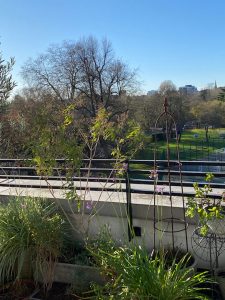 But all is transient and fleeting, without the possibility of planting for future generations, although I mitigate the regret that I can’t plant anything longer lasting by introducing anything oversized, but still transportable and productive, or popular with pollinators, to the allotment whenever possible.
But all is transient and fleeting, without the possibility of planting for future generations, although I mitigate the regret that I can’t plant anything longer lasting by introducing anything oversized, but still transportable and productive, or popular with pollinators, to the allotment whenever possible.
Mellow Yellow
Once upon a time I bought a very short canary yellow Summer coat to wear to a friend’s wedding. I knew at the time it was a mistake. Versions of that coat can still be seen on old 60s movies – but probably not at a rather conventional wedding in the Home Counties. Yellow stands out, which makes it wonderfully welcome early in the year as daffodils followed by primroses then buttercups light up the yet to be greened up spaces in gardens, meadows and on motorway margins. But it’s a difficult colour as the year progresses, particularly in small spaces, as rather like my eye-catching coat it can be very distracting when really the spotlight should be directed elsewhere.
So I now eschew yellow roses or calendula and keep to well honed colour tones that sit happily together. These albeit conventional choices of whites, pinks with soft mauves and purples are reliable, dependable and flatter the space without demanding too much attention and happily cohabit with the occasional apricot rose or shocking pink salvia to add a bit of spice to the mix.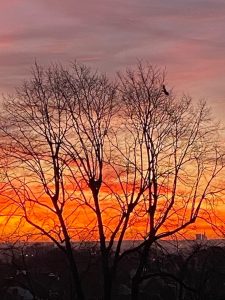
However, the person I live with likes bright colours (although even he would probably have thought my yellow coat was a step too far) but interestingly it appears he sees colour rather differently from me. Not conventionally colour blind but with a flatter perception of colour, so that intermingling leafy greens come across as dull. I’ve written before about my father who planted pots with ever more vivid shades of bright red, almost scarlet, as he grew older, and his eyes dimmed, and my brother who has a specific eye condition which also reduces his capacity to appreciate soft colour combinations.
But regrettably, there are limits to my generosity with ‘pops of colour’ or brighter flowering combinations. I try, but it’s a struggle. Eye catching bulbs promising brightly coloured flowers are put aside, yellow narcissi are replaced by elegant white thalia and vivid (garish) yellow forsythia doesn’t get a look in. Instead the mainstay of my bulb planting this year are snakeshead fritillaria, with nodding flower heads, generally in soft shades of purple.
This year I’ve even been cautious with the tulips and gone for very soft pinks which I’m already beginning to question. And as to the wisdom of planting snakeshead fritillaria, a plant happiest in meadows, they do flower well for a season or so in containers, but I failed in my attempt to grow them from seed a year or so ago.
The National Garden Scheme
As with life, so with visiting gardens, so much I might have given more time to.
I’ve dipped in and out of the yellow book, the Garden Visitors Handbook, over the years and certainly haven’t visited enough. I did though man (or womanned) a cake stall many years ago in support of some lovely London gardens running down to the Thames and open to the public. It was indeed a long time ago and my memory, maybe false, is of a riverside path somehow dividing the part of the gardens closest to the houses from lower sections which ran down to the river’s edge, with the cake stall just outside a wooden structure, which I think was a garage but of course that would suggest a road rather then a path. It’s probable that my recollections of the geography are very wide of the mark, while the gardens, of a certain type, were more likely to be spot on: well cared for, beautiful spaces with roses at the heart of things.
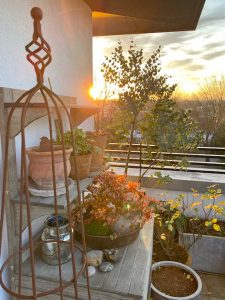 There were perhaps three or four along this particular stretch of the north bank of the Thames. I wasn’t responsible in any way for providing the cakes, but with a friend was quite good at encouraging people to enjoy them, while glimpsing very enviously, at the gardens all around. Meanwhile as I write, black poplar trees are being carefully planted along the water’s edge on the south bank more or less opposite. It is a declining species in the UK and ‘grows best in boggy conditions, near ditches and flood plains’ so should be well suited to the often water logged land adjacent to the footpath.
There were perhaps three or four along this particular stretch of the north bank of the Thames. I wasn’t responsible in any way for providing the cakes, but with a friend was quite good at encouraging people to enjoy them, while glimpsing very enviously, at the gardens all around. Meanwhile as I write, black poplar trees are being carefully planted along the water’s edge on the south bank more or less opposite. It is a declining species in the UK and ‘grows best in boggy conditions, near ditches and flood plains’ so should be well suited to the often water logged land adjacent to the footpath.
All of which leaves me hoping for enough winter sun-shine to enjoy gardens of all sorts, although this will tend to be brief glimpses as I pass by, while also hoping for enough winter rain to boost the survival rate of all newly planted trees hereabouts and elsewhere.
I grew up in the metroland of John Betjeman, a woody area with generously sized houses, Edwardian mostly, that had arrived with the extension West of the Metropolitan line. The gardens had been designed with horses and carriages in mind and often included swimming pools or tennis courts, although ours had long since been grassed over. The former front door had become the door to the main lawn while the side of the house was gravelled to better suit the arrival of motor-cars and the requirement to build a garage. To this day the space given to motor cars is, I’ve heard, over-generous, but much more absorbing were stories about the blacksmith who used to work under the enormous elm tree at the bottom of the garden and the edited first hand accounts of the first World War from our heroic gardener who had spent four years as a gunner in the trenches.
After the war, and married to his childhood sweetheart, this highly intelligent, kind and wise man, who had missed out on formal education, completed an agricultural training scheme, one of many horticultural and agricultural projects aimed at helping demobbed soldiers adjust to post war life and improving ‘veterans’ health and their prospects’. Sue Stuart-Smith touches on the value of these courses in her book ‘The Well Gardened Mind’, which I have mentioned before. If you have not already done so I urge you to buy it, read it and pass it on.
The National Garden Scheme has long since recognised the value of visiting beautiful, interesting and very personal gardens. It has supported a range of training schemes as well as advocating the value of practical gardening tasks in the recovery from both psychological and physical challenges and has also raised over £63 million for Hospice UK.
For anyone who hasn’t got a copy of the yellow book to hand, more personal entries with details of gardens that are periodically open to the public under the National Garden Scheme, can be found on Instagram. If you are in reach of the East Riding you might like to follow Helen Marsden @marsdengarden. She and her husband have created a garden, ponds with woodland and grazing on a sixteen acre site.
So an enviably different scale from my small roof terrace and different again from the scale of the planetary system which governs the Winter solstice, and which if interested can be explored in greater detail by surfing the internet at https://www.google.co.uk/search?q=the+winter+solstice+2021&sxsrf=AOaemvIA5zPK6KsSB795_lMCg1BNzUxodw%3A1640260873020&source=hp&ei=CGXEYcvtO4Sx8gK6rZzoBw&iflsig=ALs-wAMAAAAAYcRzGaNUuvxScdySxCHPJo8Y_TFm815z&oq=the+winter+solstice+2021&gs_lcp=Cgdnd3Mtd2l6EAEYADIFCAAQgAQyBggAEBYQHjIGCAAQFhAeMgYIABAWEB46BwgjEOoCECc6DQguEMcBEK8BEOoCECc6BAgjECc6CwgAEIAEELEDEIMBOhEILhCABBCxAxCDARDHARCjAjoLCC4QgAQQsQMQgwE6DgguEIAEELEDEMcBENEDOhEILhCABBCxAxCDARDHARDRAzoLCC4QgAQQxwEQ0QM6DgguEIAEELEDEMcBEKMCOggILhCxAxCDAToKCC4QxwEQrwEQJzoLCC4QgAQQxwEQrwE6CAguEIAEELEDOggIABCxAxCDAToQCC4QgAQQhwIQxwEQrwEQFDoICAAQgAQQsQM6BQguEIAEOgoILhCABBCHAhAUOhAIABCABBCxAxCDARBGEIECUK0NWL9XYLFzaAFwAHgAgAGqA4gBpxqSAQoxMS44LjMuMS4xmAEAoAEBsAEK&sclient=gws-wiz
I hope you enjoy exploring your own world in brief moments, on your own or with others, over the festive season.
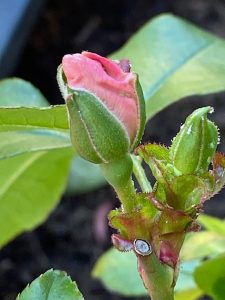
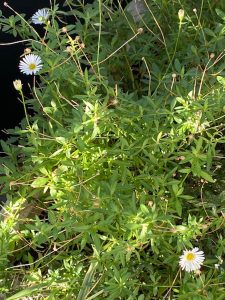
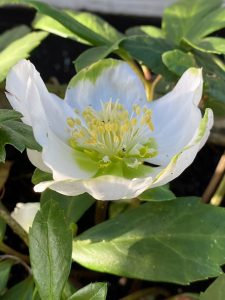
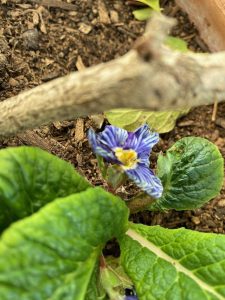
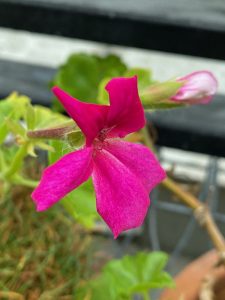
What an interesting autobiography! I heard on the radio this week that daylight on Dec. 22 would be 22 seconds longer than daylight on Dec. 21 which though not very significant is nevertheless a sign in the right direction. In our garden on Wimbledon at ground level we have a hydrangea still in flower and not yet lost it’s leaves but it’s probably warmer than yours at 5th floor. I did look in the RHS annual book for 5th floor gardens to visit but found none. Just now I am in Galway where the day is 3/4 hour later than back home and I wonder if that affects plants growth?
We look forward now to what Spring will bring us!
With love
Peter.
Many thanks for your comment and the interesting details regarding the incremental changes in day length, now we are past the shortest day, as well as the later sunsets as you move West. I’m aware that gardening articles in print or other media often do comment on the later planting times in Spring / early Summer as you move north, but I hadn’t really given the horticultural implications of moving further West any thought until now. Instead I’ve rather taken for granted the familiar early arrival in London of Spring flowers that have been grown and picked in the Scilly Isles.
This was lovely to read and I have ordered the Sue Stuart Smith book and asked Helen Marsden if I can follow her. If you get many sunsets like that photo I’m not sure you need any pops of colour!
Doesn’t the Gulf Stream has a lot to do with milder west coast gardens? Inverewe garden in Wester Ross in Scotland has an amazing collection of exotic plants which would certainly succumb here in Yorkshire. Whether those warm currents are going to survive climate change is another matter.
Happy New Year
Happy New Year.
At last I have had the time to read your wonderful article. I have it fascinating and am so intrigued how you manage to garden in those conditions. I love the story of your yellow coat.